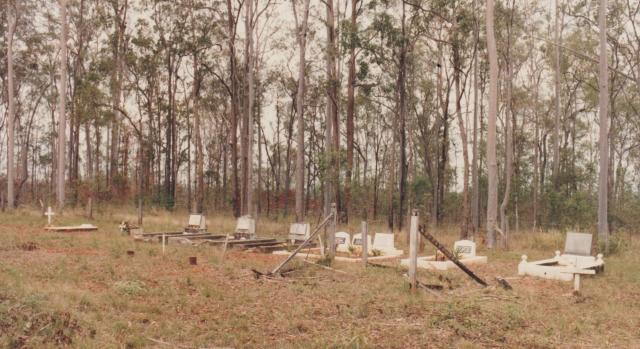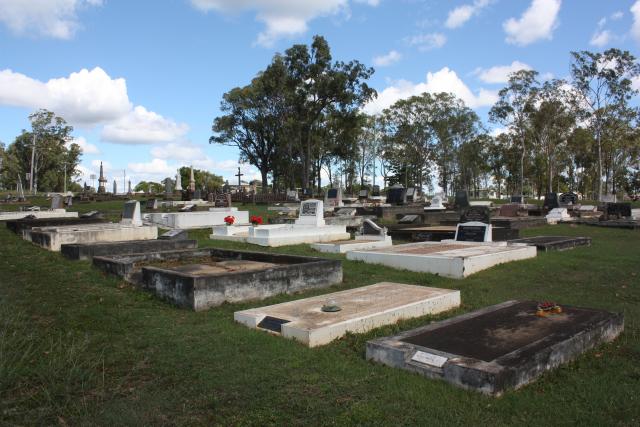Booyal Cemetery
The cemetery at Booyal is located on Berthelsens Road/German Charlies Road.
The earliest known burial is Richard Longhurst in 1908 while the earliest headstone is 1919.
There are many unmarked graves and some headstones are without marks.
No early records exist.
The cemetery occupies only a small portion of a larger lot of approximately three hectares and consists of a cleared and levelled area.
5/12/1919 Maryborough Chronicle, Wide Bay and Burnett Advertiser.
“On the 20th November, a very old resident pioneer of Booyal, John Laynton, passed away at his son’s residence at Booyal.
The deceased was born at Market Drayton, England, and was by profession a gamekeeper, prior to embarking to Queensland with his wife, and two daughters and three sons in the sailing ship Scottish Lassie in 1888.
He started work at Tegege, near Bundaberg, and later on selected a scrub farm on the Burnett River at Booyal, and there started his Queensland pioneering.
He began with orange and citrus culture which proved most successful, having produced some of the finest samples of oranges in Queensland and thus proved the Booyal lands to be well adapted for profitable citrus culture.
The deceased had been ailing for some time. He was 74 years of age. The funeral at the Booyal cemetery was a very large and representative one.
The deceased is survived by his widow, three sons, John, Thomas and George and two daughters, married, Mrs Hennessey (Gin Gin Central Mill) and Mrs Anderson (Gin Gin), to whom the whole district extends its sincere sympathy in their sad bereavement”.
South Isis Cemetery
The cemetery at South Isis is located on Aerodrome Road off the Bruce Highway.
The cemetery contains graves of early settlers in the district, some of whose descendants still live in the district. South Isis Cemetery is an historical cemetery which ceased operation in the 1940s, when it was discovered to be flood prone and therefore a health risk, and Apple Tree Creek Cemetery became the main cemetery in the district.
The grounds have recently been cleared and some grave restoration has taken place. The rectangular cemetery site occupies approximately eight hectares.
16/10/1899 Bundaberg Mail and Burnett Advertiser
“The trustees of the South Isis Cemetery applied for an extra 10 acres, which has been granted, and has now been surveyed by Mr A.J. Aldridge”.
‘South Isis Cemetery’
Taken from the notes: They Died Before Their Time – The Dangerous Lives of Our Pioneers
“Hidden in the trees off Aerodrome Road, south of Childers, are the remnants of South Isis Cemetery.
Travelling past, if you’re lucky, you’ll glimpse white fences off in the distance among the tree trunks.
The reserve is almost completely treed, having been deserted for at least 40 years. Few stones of any substance remain to tell the story of who was laid to rest here, but identities are slowly coming to light. Initially the reserve was chosen as the primary cemetery for the district. As time passed, and wet seasons came and went, it became obvious that a new location had to be found.
Some of the earliest pioneers of the South Isis are known to have been laid to rest, but their precise whereabouts are as yet unknown.
Work done many years ago helped identify some of the grave sites, but it was during recent cleaning up of the area closest the road that even more graves were uncovered closer toward a creek flowing past the back of the reserve. It’s hoped that in time, as more information becomes available, the secrets of the lost cemetery of the Isis will be uncovered”.
Cordalba Cemetery
The Cemetery at Cordalba is located on Cemetery Road off Irwins Road.
The Cordalba Cemetery proclaimed in the Government gazette of 1896, is spread over more than 9 acres and is split into Catholic and general sections.
Early graves include iron picket fences and two graves ((Russian Orthodox) with timber picket fences and eastern crosses. The cemetery is still in use.
26/10/1904 The Bundaberg Mail and Burnett Advertiser
“Sunday last was a day which will long be remembered in Cordalba.
When it became known that Harry Pothecary had passed away and was to be buried in the local cemetery, numbers of friends visited the parents and expressed their condolences with them, bringing wreaths, bouquets, etc. with them.
At 4.30pm. when the Rev J. Weir arrived, the service was commenced at the home of Mr and Mrs Pothecary and the deceased’s favourite hymn Beautiful Words was sung.
Then, at his dying request, his late companions carried him to the grave, where over 800 people witnessed the last sad rites for the dead. The funeral was the largest ever seen in Cordalba, if not in the Isis, and it shows to the parents that great sympathy is felt for them in their sad bereavement”.
Harry was approx. 19yrs old.









